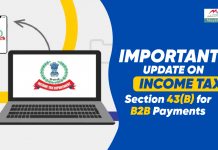Section 206CCA of the Income Tax Act was introduced by the Finance Act, 2021, and has been effective since 1st July 2021. This section mandates that any person who is responsible for deducting tax at source (TDS) is required to obtain a Tax Deduction and Collection Account Number (TAN) and link it with their Aadhaar card. Failure to comply with these requirements may lead to the deduction of TDS at a higher rate of 5% instead of the regular rate.
In this blog post, we will delve into the details of Section 206CCA of the Income Tax Act and discuss its implications for taxpayers and deductors.
What is Section 206CCA of the Income Tax Act?
Section 206CCA of the Income Tax Act is a new provision that mandates taxpayers who are responsible for deducting tax at source (TDS) to obtain a TAN and link it with their Aadhaar card. This section was introduced by the Finance Act, 2021, and became effective from 1st July 2021.
The main aim of this provision is to ensure that taxpayers comply with the TDS provisions of the Income Tax Act and to discourage the practice of tax evasion. It also seeks to promote the use of Aadhaar cards as a means of identification for taxpayers.
Who does this section apply to?
Section 206CCA applies to all persons responsible for deducting tax at source (TDS) under Chapter XVII-B of the Income Tax Act. This includes employers, banks, financial institutions, and other entities that are required to deduct TDS.
What are the requirements under Section 206CCA?
The main requirement under Section 206CCA is that any person who is responsible for deducting tax at source (TDS) is required to obtain a TAN and link it with their Aadhaar card. This requirement applies to both resident and non-resident taxpayers.
The linking of TAN with Aadhaar is a one-time process, and taxpayers need to ensure that their TAN and Aadhaar details are updated and accurate. Failure to comply with these requirements may lead to the deduction of TDS at a higher rate of 5% instead of the regular rate.
How does Section 206CCA affect taxpayers and deductors?
Section 206CCA has a significant impact on both taxpayers and deductors. For deductors, it means that they need to ensure that they have obtained a TAN and linked it with their Aadhaar card. They also need to verify the TAN and Aadhaar details of the deductees before making any TDS payments.
For taxpayers, it means that they need to ensure that their TAN and Aadhaar details are updated and accurate. Failure to comply with these requirements may result in the deduction of TDS at a higher rate of 5%, which can significantly impact their cash flows.
What are the implications of non-compliance?
Non-compliance with the provisions of Section 206CCA can have serious implications for both taxpayers and deductors. For deductors, failure to comply with these requirements can result in penalties and fines. For taxpayers, it can result in the deduction of TDS at a higher rate of 5%, which can impact their cash flows and result in a higher tax liability.
One of the key objectives of Section 206CCA is to discourage non-compliance with the TDS provisions of the Income Tax Act. By linking TAN with Aadhaar, the government aims to increase transparency and accountability in the tax system and prevent tax evasion.
The requirement of linking TAN with Aadhaar is applicable to both resident and non-resident taxpayers. It is important to note that even if a taxpayer has already linked their Aadhaar with their PAN (Permanent Account Number), they still need to link their TAN with their Aadhaar to comply with the provisions of Section 206CCA.
It is also worth noting that the provision of Section 206CCA applies to deductors who are responsible for deducting TDS on behalf of the government. This includes employers, banks, financial institutions, and other entities that are required to deduct TDS.
In case of non-compliance with the provisions of Section 206CCA, the deductor will be liable to deduct TDS at a higher rate of 5% instead of the regular rate. This higher rate of TDS can lead to cash flow issues for taxpayers and can result in a higher tax liability.
To comply with the provisions of Section 206CCA, taxpayers and deductors need to ensure that their TAN and Aadhaar details are updated and accurate. They also need to ensure that they have completed the one-time process of linking their TAN with their Aadhaar.
In conclusion
Section 206CCA of the Income Tax Act is an important provision that aims to promote compliance with TDS provisions and increase transparency in the tax system. It is important for taxpayers and deductors to comply with the provisions of this section to avoid penalties and higher rates of TDS.
Read more useful content:
- section 234e of income tax act
- section 286 of income tax act
- section 90a of income tax act
- section 40a(7) of income tax act
- section 226(3) of income tax act
- section 24 of income tax act
Frequently Asked Questions (FAQs)
Q: What is Section 206CCA of the Income Tax Act?
A: Section 206CCA of the Income Tax Act is a provision that mandates taxpayers who are responsible for deducting tax at source (TDS) to obtain a Tax Deduction and Collection Account Number (TAN) and link it with their Aadhaar card.
Q: Who does this section apply to?
A: Section 206CCA applies to all persons responsible for deducting tax at source (TDS) under Chapter XVII-B of the Income Tax Act. This includes employers, banks, financial institutions, and other entities that are required to deduct TDS.
Q: When did Section 206CCA become effective?
A: Section 206CCA became effective from 1st July 2021.
Q: What is the purpose of Section 206CCA?
A: The purpose of Section 206CCA is to ensure that taxpayers comply with the TDS provisions of the Income Tax Act and to discourage the practice of tax evasion. It also seeks to promote the use of Aadhaar cards as a means of identification for taxpayers.
Q: What are the requirements under Section 206CCA?
A: The main requirement under Section 206CCA is that any person who is responsible for deducting tax at source (TDS) is required to obtain a TAN and link it with their Aadhaar card. This requirement applies to both resident and non-resident taxpayers.
Q: What are the implications of non-compliance with Section 206CCA?
A: Non-compliance with the provisions of Section 206CCA can result in penalties and fines for deductors and higher tax liability for taxpayers. Deductors who fail to comply with these requirements may also be liable to deduct TDS at a higher rate of 5% instead of the regular rate.
Q: How can taxpayers and deductors comply with the provisions of Section 206CCA?
A: To comply with the provisions of Section 206CCA, taxpayers and deductors need to ensure that their TAN and Aadhaar details are updated and accurate. They also need to complete the one-time process of linking their TAN with their Aadhaar.
Q: Is the requirement of linking TAN with Aadhaar applicable to non-resident taxpayers?
A: Yes, the requirement of linking TAN with Aadhaar is applicable to both resident and non-resident taxpayers.
Q: Can taxpayers use their PAN instead of TAN for TDS deductions?
A: No, taxpayers cannot use their PAN instead of TAN for TDS deductions. TAN is a separate identification number that is required for TDS deductions.

































